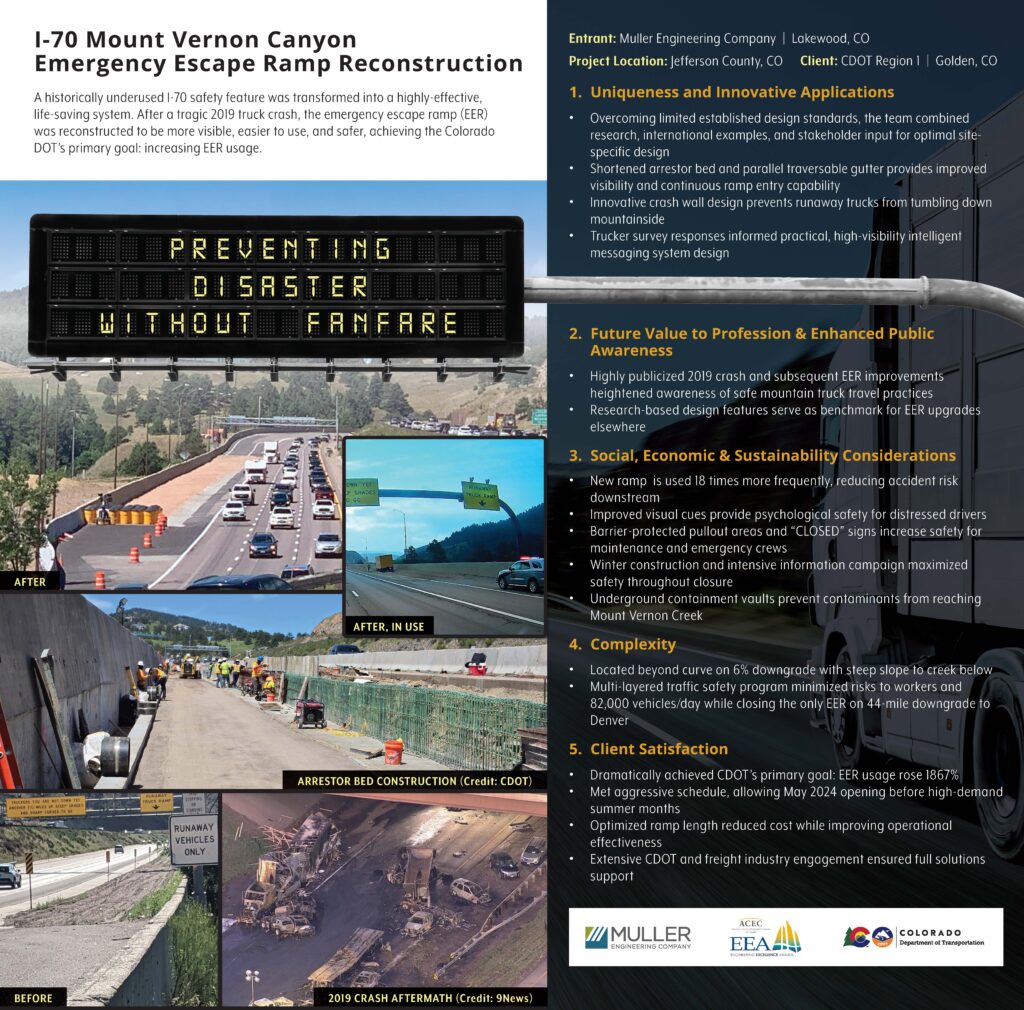Tragedy struck Colorado’s I-70 Mount Vernon Canyon in April 2019 when a semi-truck with failed brakes bypassed the existing emergency escape ramp (EER) and barreled into stopped traffic, sparking a deadly chain-reaction crash that killed four people. This corridor, the primary gateway from the continental divide to the Denver metro area, has a history of runaway truck incidents. The Colorado Department of Transportation’s (CDOT) Region 1 had one urgent goal: ensure truck drivers in distress use the ramp, preventing future disasters. Muller Engineering Company (Muller) answered that call, redesigning the I-70 Mount Vernon Canyon Emergency Escape Ramp by delivering technical excellence that directly saves lives.
The Problem and the Challenges: Despite its critical location, the original ramp was underused due to poor visibility, hidden placement behind a curve, intimidating infrastructure, and limited approach options. Site conditions made reconstruction complex: the ramp is perched on a steep slope above Mount Vernon Creek, adjacent to a highway carrying 82,000 vehicles per day. Construction had to be completed without taking the ramp offline during the summer when brake failures peak, which meant an aggressive winter-only construction schedule in snow, freeze-thaw cycles, and limited daylight. Additionally, standard design manuals for urban-adjacent mountain EERs do not exist, requiring the team to create customized, right-sized solutions.
Innovative, Human-Centered Solutions: The redesign transformed the ramp into a trusted, highly visible safety feature. Key innovations include:
- Repositioned Entrance & Longer Runway – The ramp’s entry was made more visible and easier to navigate, giving drivers crucial seconds to react.
- Custom TL-5 Impact-Rated Crash Wall – Engineered to withstand a 260,000-pound impact, this wall prevents runaway trucks from tumbling into the canyon and gives drivers the confidence to commit to entry.
- Traversable Gutter Pan – Replacing the barrier curb, the traversable gutter pan allows late entry even if another truck is already using the ramp.
- Maintenance & Recovery Upgrades – Barrier-protected pull-off bays and tow anchors enable quick, safe recovery operations, minimizing impacts to traffic.
- Intelligent Transportation Systems – Real-time message boards, alternating flashing beacons, closed circuit television monitoring, and future-ready detection capabilities, all based on feedback from over 3,000 truck drivers.
- Environmental Safeguards – Underground firewater containment vaults protect Mount Vernon Creek from hazardous runoff in the event of a vehicle fire.
Engagement and Collaboration: From day one, the project relied on stakeholder input. Muller worked closely with CDOT’s Freight Office, the Colorado Motor Carriers Association, State Patrol, and other emergency responders to ensure the design met both engineering standards and user trust needs. Outreach campaigns reached truckers across multiple states, educating them on operational changes and improving their comfort with using the ramp.
Measurable, Life-Saving Impact: The results are immediate and striking:
- Ramp use jumped from 6 times in 8 years to 14 times in the first year after reconstruction—each event a potential tragedy prevented.
- Drivers report increased confidence in using the ramp thanks to improved sightlines, signage, and physical protections.
- Emergency responders and maintenance crews operate more safely and efficiently with new pull-off bays and recovery anchors.
- The project reduces crash-related injuries, fatalities, insurance claims, and traffic delays, protecting the surrounding communities of Golden, Lakewood, and Denver.
Efficient, On-Budget Delivery: Muller compressed design from the typical 12 months to just 3 months, enabling CDOT to bid and build the project in the winter low-risk window. The $20.2M project was delivered on time and under budget. Despite harsh weather, crews maintained safety and quality while keeping three lanes of high-speed traffic open through the canyon.
Why This Project Deserves Recognition
This is not a massive, high-dollar landmark project—it’s something far more impactful. It takes a site of tragedy and transforms it into a model of proactive safety design. It blends engineering innovation, driver psychology, environmental stewardship, and stakeholder trust into a single, seamless system.
The I-70 Mount Vernon Canyon Emergency Escape Ramp Reconstruction proves that engineering excellence is not measured by scale, but by the people it serves and the lives it saves. It stands as a national benchmark for context-driven safety infrastructure and a testament to engineering’s highest purpose: protecting people in moments they never knew they needed protection.
